The Colour is Purple
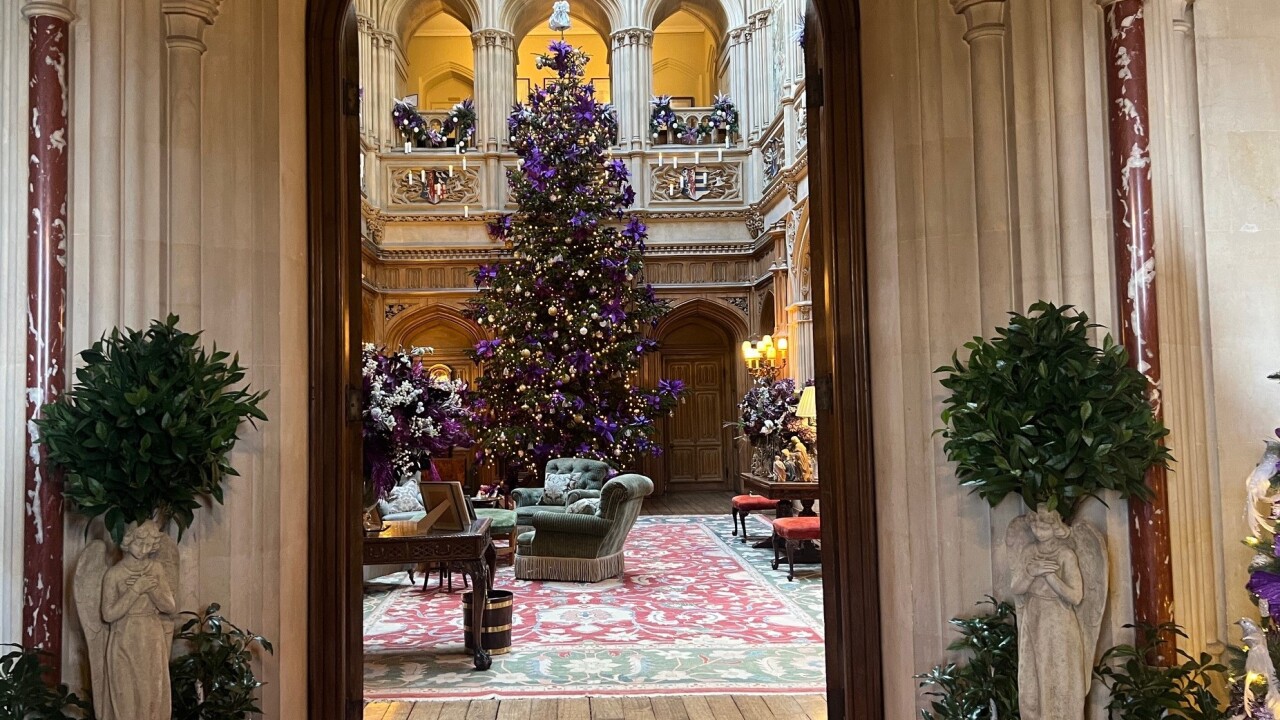
The Colour is Purple
 It has been a week of Elf work – a teambuilding exercise Highclere style as we all turn into Sally’s Christmas elves for 10 days, although thankfully not wearing green tights. Little Christmas trees, big ones and all sizes in between have all been brought in, floral decorations, half made garlands, wreaths for the front door and mantelshelf works of art... and, just like in any fairy story it was off to work we went.
Sally and I sit down over coffee in January to plan the next two years ahead for our Christmas bright ideas. The idea emerge from Christmas traditions and Highclere history. This year we have taken inspiration from the medieval heritage of Highclere and the predominant colour theme is a rich deep purple.
The Highclere Estate belonged to the Bishopric of Winchester for over 800 years. In fact Highclere’s first written records date from 749 and the estate gradually grew in importance from a monastic farm until it was transformed in the 13th and 14th centuries into a Bishop’s palace.
It has been a week of Elf work – a teambuilding exercise Highclere style as we all turn into Sally’s Christmas elves for 10 days, although thankfully not wearing green tights. Little Christmas trees, big ones and all sizes in between have all been brought in, floral decorations, half made garlands, wreaths for the front door and mantelshelf works of art... and, just like in any fairy story it was off to work we went.
Sally and I sit down over coffee in January to plan the next two years ahead for our Christmas bright ideas. The idea emerge from Christmas traditions and Highclere history. This year we have taken inspiration from the medieval heritage of Highclere and the predominant colour theme is a rich deep purple.
The Highclere Estate belonged to the Bishopric of Winchester for over 800 years. In fact Highclere’s first written records date from 749 and the estate gradually grew in importance from a monastic farm until it was transformed in the 13th and 14th centuries into a Bishop’s palace.
 Medieval bishops had the same social stature and wealth as the nobility and lived in the same luxury. They were great landowners; princes of the church and Bishop William of Wykeham (1324-1404) was the Chancellor of England and architect to King Edward III as well as the Bishop of Winchester.
As a Bishop and politician, William was constantly on the move. Highclere Palace would have had cavalcades of horsemen, packhorses and carts arriving throughout the year although levels of activity would vary depending who was in residence. There would have been a large household staff – accountants, stewards, bailiffs and reeves all coming and going from various manors and tenants on the estate.
Medieval bishops had the same social stature and wealth as the nobility and lived in the same luxury. They were great landowners; princes of the church and Bishop William of Wykeham (1324-1404) was the Chancellor of England and architect to King Edward III as well as the Bishop of Winchester.
As a Bishop and politician, William was constantly on the move. Highclere Palace would have had cavalcades of horsemen, packhorses and carts arriving throughout the year although levels of activity would vary depending who was in residence. There would have been a large household staff – accountants, stewards, bailiffs and reeves all coming and going from various manors and tenants on the estate. The palace developed during the 13th century but one hundred years later it was one my heroes William of Wykeham who saw it reach an extraordinary pre eminence. With inner and an outer courtyard, gatehouse, a chapel and a range of ancillary buildings including guest accommodation, a brewery, buttery, kitchen and bakery, hen house and goat house, stables, ox sheds and cart houses in addition to vast cathedral like barns to store the grain.
The palace developed during the 13th century but one hundred years later it was one my heroes William of Wykeham who saw it reach an extraordinary pre eminence. With inner and an outer courtyard, gatehouse, a chapel and a range of ancillary buildings including guest accommodation, a brewery, buttery, kitchen and bakery, hen house and goat house, stables, ox sheds and cart houses in addition to vast cathedral like barns to store the grain. Like any great feudal estate, Highclere Palace would have aimed at a fair degree of self-sufficiency.
There was a deer park, oaks forests, pasturage, orchards, vegetable and herb gardens and five fishponds at Milford Lake. There was a large and profitable sheep industry alongside arable farming including wheat, barley and oats. Dairy goods are frequently referenced in the estate records, particularly cheese and butter. Several forms of fresh meat were available including rabbit, pork, mutton, beef and venison.
Like any great feudal estate, Highclere Palace would have aimed at a fair degree of self-sufficiency.
There was a deer park, oaks forests, pasturage, orchards, vegetable and herb gardens and five fishponds at Milford Lake. There was a large and profitable sheep industry alongside arable farming including wheat, barley and oats. Dairy goods are frequently referenced in the estate records, particularly cheese and butter. Several forms of fresh meat were available including rabbit, pork, mutton, beef and venison.
 One of the Anglo-Saxon boundary tracks on the estate, now the modern A343, was called Hunig Weg (literally Honey Street) most likely because that was where many of the hives were found. Honey was essential for health, as a sweetener and for beeswax.
Deer parks around the main residence bounded by ditches and banks. At their peak at the turn of the 14th century, deer parks may have covered 2% of the land area of England.
One of the Anglo-Saxon boundary tracks on the estate, now the modern A343, was called Hunig Weg (literally Honey Street) most likely because that was where many of the hives were found. Honey was essential for health, as a sweetener and for beeswax.
Deer parks around the main residence bounded by ditches and banks. At their peak at the turn of the 14th century, deer parks may have covered 2% of the land area of England.
 Although beer may have been invented by the ancient Babylonians, it was perfected by medieval monasteries that gave us brewing as we know it today. Medieval Highclere had its own brewery using barley from the estate. Today Highclere’s beer is made locally and sold only at the castle.
Equally impressive is the religious contribution to distilled spirits. Without doubt mead was brewed at Highclere and perhaps other spirits as well. Today the castle is famous for its award-winning Gin, wrapped in its purple bottle like the bishops of old and made using botanicals from the estate. Thus spirit in all shades of purple, tied in to the land and landscape will welcome and entertain all of our guests this year.
Although beer may have been invented by the ancient Babylonians, it was perfected by medieval monasteries that gave us brewing as we know it today. Medieval Highclere had its own brewery using barley from the estate. Today Highclere’s beer is made locally and sold only at the castle.
Equally impressive is the religious contribution to distilled spirits. Without doubt mead was brewed at Highclere and perhaps other spirits as well. Today the castle is famous for its award-winning Gin, wrapped in its purple bottle like the bishops of old and made using botanicals from the estate. Thus spirit in all shades of purple, tied in to the land and landscape will welcome and entertain all of our guests this year.
57 Comments
Beautiful sentiments, as always, Lady Carnarvon! And your decorations are lovely. Holiday blessings to you and your family.
You brought me there for few minutes. It was magic. A true fairy tale. Thank you very much
So beautifaul, Happy Holidays to you and your family.
fondly Jenny
Everything is gorgeous. Happy Christmas!
Lovely the picture The colour is purple and lovely to highcelere castle and lam fan of Downton Abbey and did you and lord Carnarvon have a nice weekend and lovely Christmas it my birthday on Boxing Day thank you for the email very kind of you
Happy early birthday, Karen. May you have a fun and joyful day on Boxing Day!
Lovely pictures the colour of purple did you and Lord Carnarvon have a nice weekend and lovely highcelere castle and fan of Downton Abbey thank you for the email
Beautiful trees and decorations ,thank you another interesting read ,
Hello Lady Carnarvon
When you next unwrap a bar of Cadbury's Chocolate, that you probably often do, it is always wrapped in purple. Why? Victoria's favourite colour.
Carry on Highclere
Pity it no longer tastes like Cadbury chocolate used to taste like
I love hearing the history of Highclere. After having the privilege to visit in 2016, it is wonderful to learn more about your amazing home. Thank you for sharing!
'Tis the Season! So good to read the history of Highclere, and how appropriate for it to become the main character in the "Downton ABBEY" series, as it was a monastic estate once upon a time! Beautiful purple theme for your Holiday decor. I am loving the feathers and snowflakes on the hallway tree, plus, of course the beauty of the main tree in the saloon. But so clever is the "gin, lemon and drinks" tree with Highclere Gin boxed gifts beneath. Fabulous!
WOW!! This is an impressive recap of what Highclere looked like at turn of 14th century. Last month when we were in Stratford upon Avon we spent a few hours at Charlecote house, kitchens, brewery, laundry, carriage houses and deer park. What a treat it was to walk on public paths through their deer park. Although I was a tad nervous as we passed big rutting males clashing their with huge tan colored antlers. They have about 180 fallow deer at Charlecote. And to think that deer parks may have covered 2% of England's land!! Thanks for another great Monday morning read up on Highclere's history.
Ina Sue
Bellingham, WA
Thank you Ina Sue
The purple theme is beautiful. I have fond memories of visiting Highclere at Christmas and hope to return in the future. May you and yours have a blessed Advent and Christmas.
What a wonderful trip through medieval Highclere history reading this Christmas decoration post! You’ve illuminated how life was at the castle and given such illustrative details I can just imagine how it really was. Thank you and let the celebrations begin! ❤️
Those elves are really talented. Many of us could barely hope to make anything half as good. Such a beautiful and welcoming sight for the coming festivities.
what a lovely site , never to early to start this wonderful time of year , THANK YOU .
Greetings Lady Carnarvon,
Beautiful photos again and very interesting information of historic ownership connection & productions of Highclere centuries ago. The purple is different for Christmas world-wide tradition colors but obviously not for Highclere which are lovely decorations for you and your visitors this season and also enjoyiing understanding the connection to your Hghclere Gin bottle color which I've been thrilled at once it began selling in the USA as it is my favorite Gin and purple is a favorite color of mine too! Thank you again for another lovely and informative Monday Morning Blog. Good luck with your holiday season approaching and remain well.
I need new glasses .... and perhaps a new brain ! I thought your first sentence said its been a week of "health" work .... but I can see why; we have been working on "elf 'n' safety" in the local church !
Love all the purple tones in your decorations !
We look so forward to seeing and experiencing all the beautiful results of your hardworking elves.
Thank you!
What a wonderful and colorful story! Do you currently have deer in the deer parks, and if so, what do they eat and what is their function for the estate?
Hello Carolyn There are still deer within the estate but they are running wild as opposed to specifically fenced in a park.
I always look forward to Monday morning and your blog Your decorations are beautiful and inspiring. I wish I could come from Virginia to see them in person. Hoping to get to highclere this year.
Thank you
Carol Lynn Forman
Thank you Carol
Wonderful decorations. The purple looks so rich and lush against the green.
Just beautiful as always. I love the deep rich purples this year too. Your hard work and dedication of keeping the memories alive and the castle and grounds beautiful is quite a testament of love your family has given to Britain and the world. Thank you for the history lessons and stories from the past and present all these years. It’s always a pleasure reading and seeing pictures each week about all things connected to the estate. I hope your holiday season is as much a pleasure for you as you bring it to us.
Merry Christmas!
Thank you for your kind words Malea, Merry Christmas to you too.
Lovely pictures the colour of purple l love Christmas it is my birthday on Boxing Day and thank you for the email
Happy Christmas to you and lord Carnarvon when it come
The decorations are beautiful, well done to you and the team for such hard work and dedication in making Highclere Christmassy- looking forward to seeing them and you all on this Saturday when we come for the tour of the castle and afternoon tea. We came last year and has the most amazing time, thank you.
See you Saturday.
Look forward to seeing you on Saturday.
My dearest Lady Carnarvon,
Good morning from Brazil,
Ranny day, 29°celcius
Is there a Christmas nativity
scene with the baby Jesus, his parents , and the wise men in Highclere the Castle ???.
Would like see it in instagram.
Lovely week for you milady.
Thank you very, very much.
There's a nativity scene in the saloon.
Among my favorite parts of Hilary Mantel's "Wolf Hall" trilogy are those sections in which Thomas Cromwell (whose non-existent job-description would seem to be "EVERYTHING") deals with the business of preparing various residences for the arrival of Cardinal Wolsey, or Henry VIII, or the newly instated Anne Boleyn.
Everything had to be perfect and supplied to the hilt and prepared for any eventuality (including, say, the king's suddenly changing his mind and veering off, with an afternoon's notice, to spend the week at some other house/castle). Weeks (or months) beforehand, Cromwell would be dispensing armies of brick-masons, embroiderers, glaziers, cooks........you name it, and the trade/profession not only existed, but had a name. And everything had better damn well be PERFECT when the Bishop or King arrived, and it had better stay perfect for the duration of the stay (by which time, Cromwell would have moved to preparing the next scheduled stopover).
By comparison, arranging a modern G20 or NATO summit sounds like a cakewalk. Of course, Henry (and, later, his daughter, Elizabeth) did all of this intentionally.....keeps everyone on their toes, you know.
It's good to see/read that you get plenty of sincere thanks and appreciation for your own, herculean work at Highclere.
We all know what Cromwell got for his efforts.
Best Wishes,
David Terry
Hillsborough, NC. USA
Thank you for the history lesson and the beautiful photos. The choice of purple is so regal. Oh, how I hope I can visit someday, especially at Christmastime.
Beautifully written and presented with such an interesting detail about Highclere's history which ties into the present. My family lives on our farm in the River Valley area of Arkansas where we mill and package only the rice we grow with one of the varieties being an Aromatic Purple. You have inspired me to work with one of our local Executive Chefs for a new Christmas Purple Rice dish.
Here's to a very Merry and Blessed Christmas!
Cheers,
Robin Ralston
Lady Carnarvon,
A beautiful, rich color - purple. Thank you for your Chrismas-tide story of the lovely history of your beautiful home and grounds.
Here’s to a calming glass of Highclere gin after you, Sally and your elves bring that history alive to your family and guests during this holy and sweet Christmas season!
Martha G
Thank you so much for the decor inspiration. The elves will visit here starting Friday! Merry Christmas!
Thank you for the lovely photos and the history lesson!
Happy Holidays!
Barbara LaPierre
Radcliff, KY, USA
Thank you for the lovely photos and the history lesson! I really enjoy getting your weekly emails!
Happy Holidays!
Barbara LaPierre
Radcliff, KY, USA
Dear Lady Carnarvon,
As always, Monday mornings are something to look forward to especially during the season leading up to Christmas. It's become somewhat a tradition to sit in the sunroom with a cup of Earl Grey and your weekly blog. The history, your words and pictures bring a sense of warmth and almost 'being there'; truly being welcomed into your season of 'Highclere's Elfin Magic' so to speak, these moments of joy that you share with us means a great deal to me as my husband passed away in August. Thank you for always sharing that happiness with us. Have a blessed holiday season!
Diane Shaffer
Cary, North Carolina
USA
Wonderful column. Enjoyed hearing about some of the history at highclere.
I am so glad you included a "creche" with The Holy Family. One well known magazine actually reversed the word "Christmas' on a banner so that people would not be offended! We live in strange times.
My father, in Kent, remembered that the Brabourne Estate supplied local towns with venison during WW1. There was no Rationing then and meat was rare so the estates provided needed protein for many people.
I have finally watched all the Downton Abbey series. All I can think of is how much the roof costs to repair and how cold it must be in winter!
Thank you for your posts, they bring reality to a fine house where everyone works so hard to , not only support the estate, but also to ensure peoples enjoyment of the place and its guardians.
Greetings Lady Carnarvon,
It's Thanksgiving Week here is the U.S., and while some have jumped the gun and already decorated for Christmas, I am however enjoying our autumn decorations, and our long tradition of decorating after Thanksgiving. Here in east and middle Tennessee, we've had the most golden and colorful fall of the year. The el Nino weather phenomanon has kept us warm and dry, so dry that we are in the throughs of a record breaking drought. Wildfires are popping up in many places, even Dollywood had to close for awhile, and I have just received an alert that The Great Smoky Mountain National Park has closed all roads into the park, and has closed all of the campgrounds. We are hoping for a long soaking rain later today and tomorrow, but less than an inch of rain is in the forecast.
Despite the dry conditions, we are enjoying the last of the autumn colors and the warm temperatures. I still have windows open and clothes on the line drying in the warm southern breeze.
It's always exciting to read about all of the holiday decorations going up at Highclere. You and your elfs do an amazing job of decorating all of the trees, garlands, and most everything else that is stationary at Highclere. It must seem a daunting task, but with eager elfs, only joy can spring from your labors. It is a joy to see the color purple used in your decorations this year. I'm using a great deal of blue this year, and must confess I have a small glass tree with blue lights in the corner just to test how it is received. So far, so good.
I'll take this opportunity to wish you and Lord Carnarvon, your family, and your staff a very Happy Thanksgiving, Though at times it seems as the world is on fire, your generous writings and photographs bring a normality to our everyday life. I look back and remember my lovely times at Highclere Castle. I felt so alive and filled with hope the last time I visited in 2018. I hope the future holds another visit to your lovely home, and to the country I enjoy so much. Christmastime at Highclere, and the city of London is perhaps my most favorite place to visit and shop during this exciting season.
Thank you Melissa for your very kind words. Wishing you and your family a very Happy Thanksgiving.
Monday morning is my favorite time. Over my first tea I troll instagram to find your blog and am transported to Highclere and you. Great way to start a week , as the words you own always calms and intrigued me. Thank you for these glimpses into your world❤️
Thank you so much for a wonderful history of Highclere. Very interesting! And your decorations are gorgeous!
Lady Carnarvon.......I can not add much to what others have already said except that the castle was beautiful before...but you have transformed it into a wonderland. Thanks for sharing the castle history and the lovely photos
On the estate, are there any deer harvested? We had a good deer herd until EHD killed 90% of them 2 years ago.
Our Thanksgiving is Thursday of this week. Hope you have a happy Thanksgiving.
Hello Mary Ann, the deer are wild. Happy Thanksgiving to you too.
Dear LADY CARNARVON,
Very interesting history lesson, I enjoyed reading this post so must.
Three & its colors are stunning & so beautiful, you have inspired me & I would
like to thank you very much for that.
May you your family & all the staff at Highclere have a wonderful Thanksgiving & a
blessed Christmas.
I have watched Downton Abbey series several times, it never gets old & I so wish to visit some year before I'm way to old. I also love the color purple its gorgeous & its also my birthstone February14th, the darker the purple its more stunning!
Enjoy Your Holidays LADY CARNARVON & LORD CARNARVON
Barbara Bouchard
Long Island, New York
USA
The purple needs the white as well but I think it is stunning too - thank you
Lady Carnarvon,
Thank you for sharing the fascinating lore of the castle history! I hope you will share more photos of the as you continue to prepare the castle for Christmas. It is my goal to see Highclere at Christmas someday.
Beautiful blog, as usual. How wonderful to see the beauty and inspiration of Highclere!
Beautiful colors and a vast and rich history. Your descriptions and pictures transport us into your wonderful world. Thank you!
Love the pictures! purple is one of my most favorite colors and your tree is lovely❣️
Dear Lady Carnarvon,
Looking just beautiful! So enjoyed our visit, picnic box, and book buying in the gift shop in May.
Here in Hyde Park, NY, flickering candles are placed in each window of our 1890 home and Christmas decorations are lovingly placed both inside and out in the gardens the day after America's Thanksgiving Day.
My relative (not a Quaker but indentured servant who nonetheless was invited to sign their governing Mayflower Compact), left Plymouth in May of 1620 and after a rough 66-day voyage in today's Massachusetts, celebrated their survival (the first Thanksgiving Day); only half of the 102 survived the cold winter.
Enjoy the season!
I visited Jamestown sometime ago - their endurance was humbling
Thank you for the lovely pictures of your Christmas decorations. I too have ornaments on my tree of lemons and oranges and other fruits and vegetables. Can't wait to get them out this year.
Dear Lady Carnarvon — those of us who love autumn and Thanksgiving are in the midst of Thanksgiving season here in the US. Autumn decorations and mouthwatering savory foods abound! Is Michaelmas when folks in Britain celebrate harvest and autumn’s bounty?
Of course, countless Christmas decorations and parades and shopping opportunities are popping up alongside the autumnal cheer. I love seeing the richness and elegance of your holiday decorations at Highclere — dignified, historic and festive, all at the same time. I adore the color purple. Somehow it strikes a deep and satisfying chord within me. Thank you for opening the Christmas season for me in such a lovely way.
Thank you - it is a very richly coloured scheme this year - with angels and we all need some angelic help
Dear Lady Carnarvon:
Such a lovely design you and the elves have envisioned that (for me anyway) brings the purple of Advent into Christmastide! I have always just removed the Advent Wreath and replaced the purple-ribboned green wreaths with white- and red-ribboned ones. You and your team have inspired me to consider adding on! Thanks for the history also! Talk about Honey Street! Your descriptions of the working estate, both past and present, and all the ‘elves’ are, to me, the very image of a bee hive! What treasures!
Have a most Happy Christmas and New Year!
Mary Goodman
Mount Jefferson
Alabama USA
We are excited to be finally coming to Highclere Castle this year for the first time. Your descriptions and pictures of Christmas at Highclere are giving us a super idea of all that we will see and experience on December 6th. With eager anticipation, thank you Lady Carnavon to you and your staff for all of your hard work and dedication!
Renee and Stephen Fehrman
La Selva Beach, California
Thank you Renee, we look forward to seeing you in December.
Mele Kalikimaka, Hou’oli Makahiki Hou to everyone at Highclere and all your followers, from the Big Island of Hawaii. I do love seeing your annual decorations, so beautiful!
Thank you for the insight into history past. Would love to see Highclere at Christmas but kind of a long was from the central US. Purple is my favorite color.
Dear Lady Carnarvon,
Thank you for this lovely blog. I can not think of a more beautiful color than purple for the tree. One of my favorites. The color of transformation and healing. My mom loved it. It is stunning.
Thank you for such a wonderful read again this week. Purple is also my favourite colour and the richness of the decorations you and your fellow Elves have put up looks both very elegant and festive. Christmas is such a wonderful season where people everywhere seem to be more friendly and helpful within their communities. It’s so lovely to see. Even giving of your time can make all the difference to someone who’s living on their own.
How I wish I could visit in person but having just been to Highclere in July, it’s not possible. Our family will all be together at some point on Christmas Day which is very special to us. We’re waiting until 1 December to put up our trees and then it will be a day of excitement getting everything on them. We have bright neon coloured cone trees on our deck so the residents in the hospital wing of our retirement village can see them every night until 6 January. We keep our curtains wide open too with the main Christmas tree near the ranch slider so they can see it too, albeit from a distance.
I look forward to seeing the next elvish chapter.
I'm way behind hand but can't resist adding a late comment! Purple? Hey but purple is the colour royal What more suitable for The King of Kings and Lord of Lords... Halleluja! etc. And it's Coronation Year. The first in this country for more than 70 years. So, a perfect choice and how sumptuous it looks, richly glowing against the polished wood and luxuriant greenery, the colours enhanced by spikes of deep pink and crystaline, Pharoanic duck egg blue that tugs a chord in the memory (thrift, thrift Horatio ?). An artfully stacked pile of purple boxed bottles of delectable Highclere Gin dispel any such notion.
So yes, Lady Carnarvon has hit the nail on the head with great accuracy as usual. Another beautifully written piece that just tweaks the dormant Monday morning brain cells. Or even the Saturday ones!
Thank you
You are so kind
Dear Lady Carnarvon:
Thank you for this Monday's blog, the brief history lesson of the Castle, and how it guided you to prepare for this Christmas season. You chose such a beautiful color and theme; enjoyed looking at the vibrant accompanying photographs.
Until next week, I wish you all best.
Perpetua Crawford
P.S. Appreciated watching the presentation on Instagram. It brought to life what I read here and made it seem more personal.
Beautiful decorations thank you for sharing.
We visted the castle yesterday on one of the Christmas tours with afternoon tea.
We specifically chose this time of year for our tour to see the decorations throughout the castle.
It did not dissapoint, it was lovely and enhanced our visit from what was already a great afternoon.
The brief you gave at the beginning of the tour was excellent and explained the reasons for this years colour scheme, which being purple pleased Karen as it is her favourite colour.
Thank you
Leave a Comment
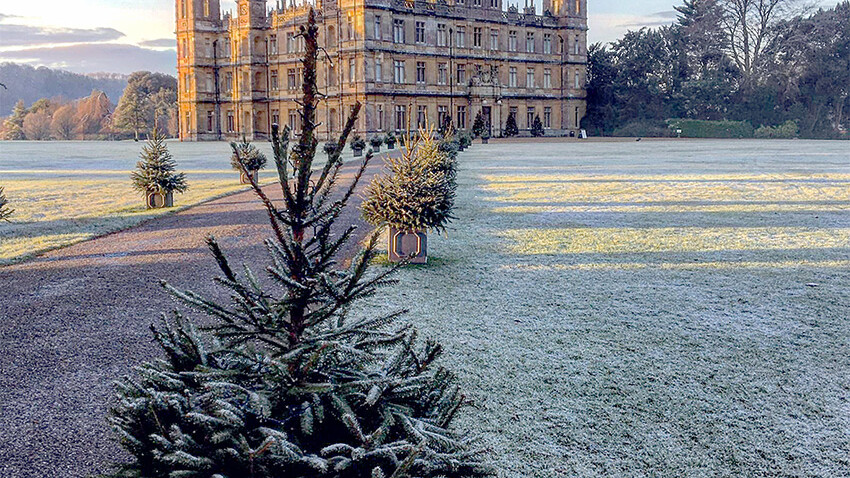
- Christmas
- Community
- Dogs & Horses
- Egypt & Tutankhamun
- Entertaining
- Farm
- Filming
- Gardens
- History & Heritage
- Daily Life
- Royalty
- Cooking
- Interiors
- Heroes
- Architecture
- Cars
- Conservation
- Downton Abbey
- Events
- Gardens & Landscape
- Highclere Castle Gin
- History
- Planes
- Restoration
- Stories & Books
- Uncategorized
- Visitors
- Wildlife

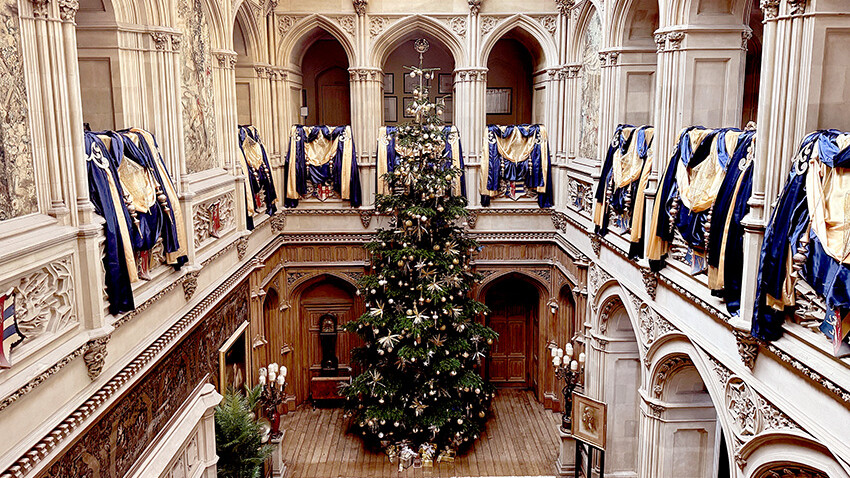
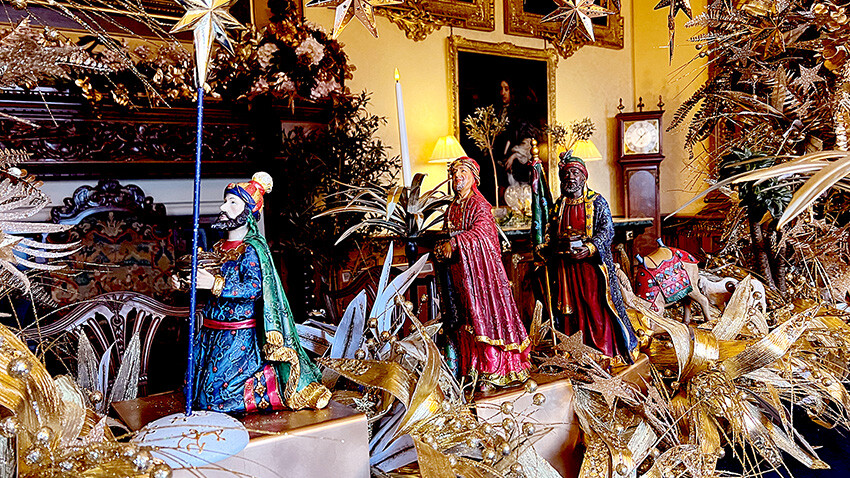
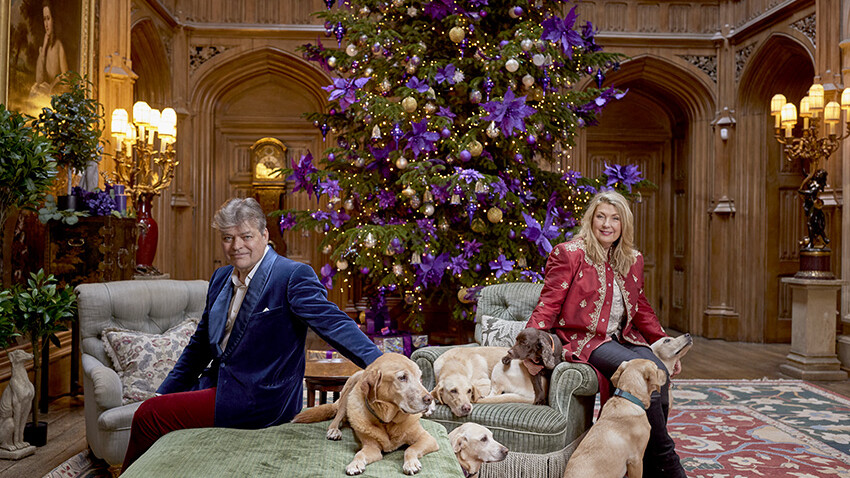
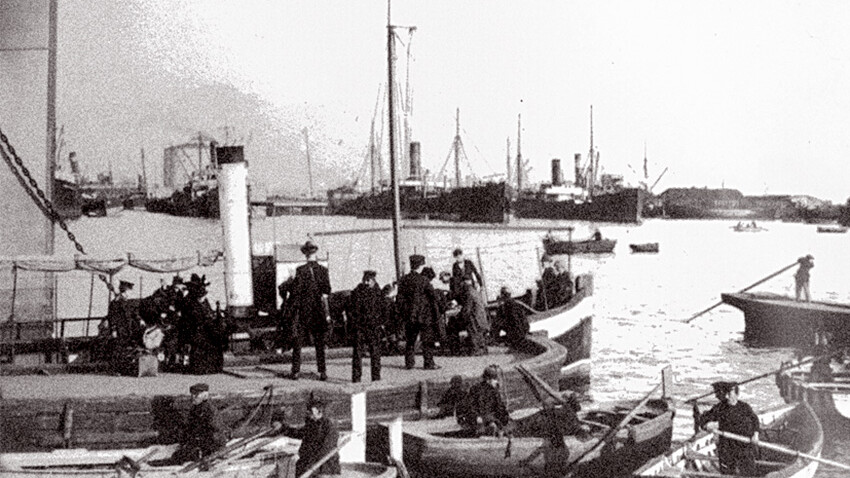
Beautiful. Thank you for all the up close photos.
Oh how beautiful! Purple is my favorite & signature color! Your early posting of the tree has given me a new idea for my own tree this year. Although clad with family made ornaments over the last 50 years, I can still incorporate many purple accents & lights for a new favorite look of my own. I wish you a very happy holiday season & Christmas.
Amy
I am sure your tree will be a triumph - silver and white and good foils
Thank you so kindly for the tour this evening with Craftours. I absolutely enjoyed it. Thank you for your great kindness to us. It was an honor to have met you. Your home is absolutely lovely! Your purple CHRISTmas decor was undeniably, the most beautiful I have ever seen May you and your family have a very wonderful and Merry CHRISTmas, this joyous season! I will never forget your kindness, friendliness, and generosity! Thank you for the photograph and your book. Much love ❤️
Thank you !